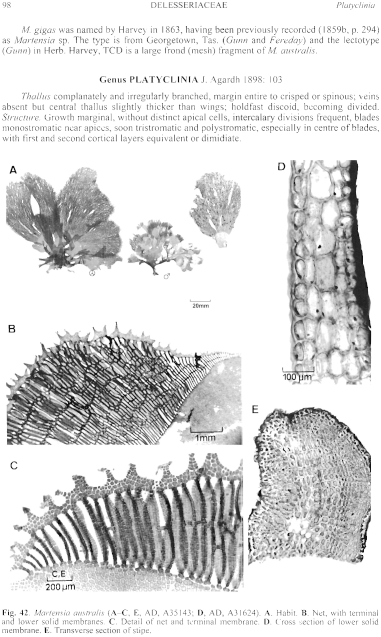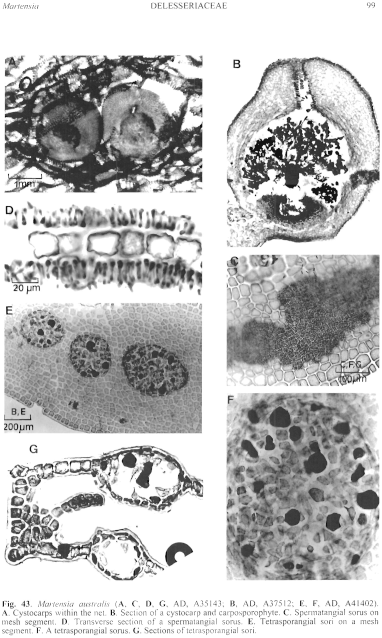|
|
|
|
|
|||||||||||
|
Electronic Flora of South Australia Species Fact Sheet
Phylum Rhodophyta – Family Delesseriaceae
Selected citations: J. Agardh 1863: 827; 1885: 87, fig. 7. Coppejans & Millar 2000: 330. De Toni 1900: 615. Huisman 1997: 202. Huisman & Walker 1990: 430. Kraft et al. 1999: 21. Kützing 1869: 22, pl. 58. Lucas 1909: 35; 1929a: 19. May 1965: 406. Millar 1990: 416, fig. 52; 1999: 519. Millar & Kraft 1993: 47. Shepherd & Womersley 1981: 366. Silva et al. 1996: 459.
Thallus (Fig. 42A) medium to dark red-brown (the net usually darker than the lower membrane), 5–20 cm high, foliose with a frequently divided frond 10–25 cm broad, borne on a single stipe usually 1–2.5 cm long and 1–2 mm in diameter; lower solid membrane 2–8 cm high and broad, mostly 150–200 µm thick, entire or lacerate or subdivided, with the upper mesh (1–) 5–15 cm high and as much or more across, radial and tangential membranes orientated at right-angles to the blades, mostly monostromatic, perforations elongate-rectangular (Fig. 42B), enlarging to 2–3 mm long and 200–400 µm wide; continuous marginal membrane (often lost) 1–3 mm across, with prominent, simple or branched, blunt spines 0.6–2 (–3) mm long (Fig. 42B). Secondary nets usually absent (see below). Holdfast discoid, 1–4 mm across; epilithic. Structure. Growth of marginal membrane (Fig. 42C) from numerous marginal cells dividing irregularly, with submarginal cells dividing to form radial chains of cells which separate laterally and undergo extensive intercalary divisions to form the main radial segments of the net, becoming linked tangentially by lateral segments; this process continues extensively to form the relatively coarse mesh, with segments 500–800 µm and 14–18 cells broad. Lower membrane 200–400 µm and 4–6 cells thick (Fig. 42D), cell arrangement regular in section. Stipe (Fig. 42E) becoming many cells thick, cells in tiers, equivalent. Mature cells multinucleate; rhodoplasts discoid, becoming chained.
Reproduction: Gametophytes dioecious. Procarps not observed. Carposporophytes (Fig. 43B) with a basal pad of ovoid, darkly staining, cells below a basal rounded to erect fusion cell bearing a gonimoblast of several large, basal, clavate cells with branched filaments of progressively smaller cells and ovoid terminal carposporangia 15–35 µm in diameter. Cystocarps (Fig. 43A) on the radial segments, globose, 1–1.5 mm across; pericarp ostiolate, 200–450 µm and 5–15 cells thick, cells in tiers. Spermatangial sari (Fig. 43C) rounded to elongate, on the mesh segments, with small cortical initials each cutting off several elongate spennatangia (Fig. 43D).
Tetrasporangial sori (Fig. 43E) rounded, scattered on the mesh segments or on the lower solid membrane, 200–400 µm across, each with several tetrasporangia (Fig. 43F) developed from primary cells and covered on each side by a layer of smaller cortical cells (Fig. 43G), tetrasporangia subspherical, 50–80 µm in diameter.
Type from King George Sound, W. Aust., lectotype Alg. Aust. Exsicc. 111B in Herb. Harvey, TCD (Trav. Set 88 missing in 1952).
Selected specimens: Elliston, S. Aust., 3–4 m deep (Shepherd, 22.x.1970; AD, A37525) and 4 m deep (Shepherd, 22.x.1970; AD, A37512). Sheringa Bay, Eyre Pen., S. Aust., 3–6 m deep, shaded (Shepherd, 22.x.1969; AD, A35143). Hopkins I., S. Aust., 25 m deep (Branden, 17.xi.1990; AD, A60846). Aldinga, S. Aust., 17 m deep in cave (F. Mitchell, 3.xii.1958; AD, A22057) and 16 m deep (F. Mitchell, 15.xi.1959; AD, A23964 and 22.xi.1959; AD, A23966 and A23967). Amphitheatre Rock, West I., S. Aust., 16 m deep (Watson, 31.viii.1969; AD, A34487). Vivonne Bay, Kangaroo I., S. Aust., 5 m deep on jetty piles (Kraft & Min Thein, 4.xii.1971; AD, A41402). Alex Lookout, E of Penneshaw, Kangaroo I., S. Aust., 10 m deep (Lavers, 25.xi.1996; AD, A66835). Margaret Brock Reef, Cape Jaffa, S. Aust., 3–5 m deep (Lewis, 29.xi.1972; AD, A42905). Lady Julia Percy I., Vic., 19 m deep (Shepherd, 4.i.1968; AD, A32444). Cape Nelson, Vic., 7–10 m deep (Shepherd, Jan. 1967; AD, A31624). 5 km off Surry R. mouth, Portland, Vic., 20 m deep (Watson, 28.xi.1981; AD, A52807). San Remo, Vic., drift (Sinkora A1906, 30.xi.1974; AD, A53462). Gabo I., Vic., 22 m deep (Millar & O'Brien, 4.xii.1996; NSW, 439078).
Distribution: Houtman Abrolhos ? (Huisman 1997, p. 202) and Rottnest I., W. Aust. (Huisman & Walker 1990, p. 430) to Coffs Harbour, N.S.W. (Millar 1990, p. 417) and N Tasmania (M gigas).
N Papua New Guinea (Coppejans & Millar 2000: 330). Philippines (Kraft et al. 1999: 21). Japan and China (see Millar 1990, p. 417).
Taxonomic notes: M australis is a deep-water species, usually in shade when in shallow depths. It is characterised by its large fronds (when mature) with a coarse mesh, marginal membrane with prominent spines, and distinct, terete, stipe. Collections from deep water off Aldinga reef, S. Aust., are typical in these respects, but AD, A23966 has developed secondary nets, as does M fragilis Harvey (see Millar 1990, p. 418); however, since the margin does show prominent spines, for the present this is regarded as an unusual variant in M. australis.
M gigas was named by Harvey in 1863, having been previously recorded (1859b, p. 294) as Martensia sp. The type is from Georgetown, Tas. (Gunn and Fereday) and the lectotype (Gunn) in Herb. Harvey, TCD is a large frond (mesh) fragment of M australis.
References:
AGARDH, J.G. (1863). Species Genera et Ordines Algarum. Vol. 2, Part 3, pp. 787–1291. (Gleerup: Lund.)
AGARDH, J.G. (1885). Till algernes systematik. VII. Florideae. Acta Univ. lund. 21, 1–120, Plate 1.
COPPEJANS, E. & MILLAR, A.J.K. (2000). Marine red algae from the north coast of Papua New Guinea. Bot. Marina 43, 315–346.
DE TONI, G.B. (1900). Sylloge Algarum omnium hucusque Cognitarum. Vol. 4. Florideae. Sect. 2. pp. 387–776. (Padua.)
HARVEY, W.H. (1855a). Some account of the marine botany of the colony of Western Australia. Trans. R. Jr. Acad. 22, 525–566.
HARVEY, W.H. (1858). Phycologia Australica. Vol. 1, Plates 1–60. (Reeve: London.)
HARVEY, W.H. (1863). Phycologia Australica. Vol. 5, Plates 241–300, synop., pp. i-lxxiii. (Reeve: London.)
HUISMAN, J.M. & WALKER, D.I. (1990). A catalogue of the marine plants of Rottnest Island, Western Australia, with notes on their distribution and biogeography. Kingia 1, 349–459.
HUISMAN, J.M. (1997). Marine Benthic Algae of the Houtman Abrolhos Islands, Western Australia. In Wells, F.E. (Ed.) The Marine Flora and Fauna of the Houtman Abrolhos Islands, Western Australia, pp. 177–237. (W. Aust. Museum: Perth.)
KÜTZING, F.T. (1869). Tabulae Phycologicae. Vol. 19. (Nordhausen.)
KRAFT, G.T., LIAO, L.M., MILLAR, A.J.K., COPPEJANS, E.G.G., HOMMERSAND, M.H. & FRESHWATER, D.W. (1999). Marine benthic red algae (Rhodophyta) from Bulusan, Sorsogon Province, southern Luzon, Philippines. Philipp. Scient. 36, 1–50.
LUCAS, A.H.S. (1909). Revised list of the Fucoideae and Florideae of Australia. Proc. Linn. Soc. N.S.W. 34, 9–60.
LUCAS, A.H.S. (1929a). The marine algae of Tasmania. Pap. Proc. R. Soc. Tasm. 1928, 6–27.
MAY, V. (1965). A census and key to the species of Rhodophyceae (red algae) recorded from Australia. Contr. N.S. W. Natl Herb. 3, 349–429.
MILLAR, A.J.K. & KRAFT, G.T. (1993). Catalogue of marine and freshwater Red Algae (Rhodophyta) of New South Wales, including Lord Howe Island, South-western Pacific. Aust. Syst. Bot. 6, 1–90.
MILLAR, A.J.K. (1990). Marine Red Algae of the Coffs Harbour Region, northern New South Wales. Aust. Syst. Bot. 3, 293–593.
MILLAR, A.J.K. (1999). Marine benthic algae of Norfolk Island, South Pacific. Aust. Syst. Bot. 12, 479–547.
SHEPHERD, S.A. & WOMERSLEY, H.B.S. (1981). The algal and seagrass ecology of Waterloo Bay, South Australia. Aquat. Bot. 11, 305–371.
SILVA, P.C., BASSON, P.W. & MOE, R.L. (1996). Catalogue of the Benthic Marine Algae of the Indian Ocean. (Univ. California Press: Berkeley.)
The Marine Benthic Flora of Southern Australia Part IIID complete list of references.
Publication:
Womersley, H.B.S. (24 February, 2003)
The Marine Benthic Flora of Southern Australia
Rhodophyta. Part IIID. Ceramiales – Delesseriaceae, Sarcomeniaceae, Rhodomelaceae
Reproduced with permission from The Marine Benthic Flora of Southern Australia Part IIID 2003, by H.B.S. Womersley. Australian Biological Resources Study, Canberra. Copyright Commonwealth of Australia.
Illustrations in Womersley Part IIIA, 2003: FIGS 42, 43.

Figure 42 enlarge
Fig. 42. Martensia australis (A–C, E, AD, A35143; D, AD, A31624). A. Habit. B. Net, with terminal and lower solid membranes. C. Detail of net and terminal membrane. D. Cross section of lower solid membrane. E. Transverse section of stipe.

Figure 43 enlarge
Fig. 43. Martensia australis (A, C, D, G, AD, A35143; B, AD, A37512; E, F, AD, A41402). A. Cystocarps within the net. B. Section of a cystocarp and carposporophyte. C. Spermatangial sorus on mesh segment. D. Transverse section of a spennatangial sorus. E. Tetrasporangial sori on a mesh segment. F. A tetrasporangial sorus. G. Sections of tetrasporangial sori.

|
Email Contact: State Herbarium of South Australia |

|